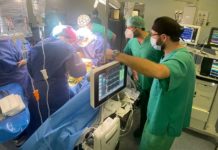Colorectal cancer is the most common malignant cancer in Spain and has second highest mortality rate. It is estimated that 32,000 new cases are diagnosed each year (15% of all tumours detected, with a prevalence of 102 cases per 100,000 inhabitants) and that more than 14,000 people die annually.
However, despite its high incidence, colon cancer is also one of the most treatable, since with early diagnosis, it can be cured in 90% of cases.
How is colon cancer detected?
Initial symptoms and clinical tests
In its early stages, colon cancer is usually asymptomatic. Even so, Dr. Pedro Bretcha, former president of the Spanish Society of Surgical Oncology and head of surgical oncology at Quirónsalud Alicante and Torrevieja, explains some of the symptoms that can alert us to the presence of this disease.
“Any persistent change in bowel habits, including diarrhoea or constipation, or a change in the consistency of the stool, can indicate the presence of colon cancer. Other initial symptoms more indicative of the disease are rectal bleeding or blood in the stool, abdominal discomfort, cramps and pains in the abdominal area, the feeling that the intestine does not empty completely, weakness, fatigue or weight loss without apparent cause,” explained Dr. Bretcha.
Currently, there are several clinical tests to detect colon cancer, including colonoscopy (every 10 years), CT colonography (every 5 years) or sigmoidoscopy (every 5 years).
Faecal occult blood tests have also been shown to be effective and can be performed annually from the age of 50.
In high-risk patients “due to family or personal history that increases the risk or suspicion” it is advisable to start checks earlier, warned Dr. Bretcha.
Colon Cancer Surgery: Laparoscopic Colectomy and Sugarbaker
The most common surgical technique for colon cancer is laparoscopic colectomy, which has similar results to open surgery, but has fewer risks and facilitates as well as a faster recovery time for patients.
“Laparoscopic colectomy has a lower incidence of transfusions, less pain in postoperative infections and hernias, shorter hospital stays and better cosmetic results,” explained Dr. Bretcha.
In addition, to this technique, the quality of life of patients operated on for colon cancer is very high: “Less than 20% require a colostomy bag, recovery from colon cancer surgery is faster and the vast majority can lead a life practically the same as before the intervention.”
Another of the techniques available is the “Sugarbaker” technique and involves the removal of all the visible tumor followed by chemotherapy in intraoperative hyperthermia (at 43 °C) to eliminate non-visible malignant cells, since heat enhances the effect of chemotherapy. Thanks to this intervention, the survival of this subgroup of patients can double.
The oncological surgery team at Hospital Quirónsalud Torrevieja was one of the first to introduce this technique in Spain in 2001. Since then, their team has performed hundreds of procedures.
The specialists of the Oncological Surgery Service of Quirónsalud Torrevieja point out that this type of intervention is quite complex and requires extensive training, with multidisciplinary teams, and specialization in oncological surgery. These efforts are rewarded by excellent results in the treatment of colon cancer after surgery.
Treatment with HIPEC makes it possible to combine high intensity chemotherapy, focused on the affected area, with less systemic toxicity.
Can colon cancer be prevented?
The answer is that there is no way to prevent it 100%, although we can reduce or eliminate some risk factors (poor diet, alcohol, tobacco and a sedentary lifestyle).
Nevertheless, there are other factors we cannot change, including:
- Aging (Most cases are detected after the age of 50)
- History of colorectal cancer or colorectal polyps
- History of inflammatory bowel disease
- Family history
- Ethnic and racial background (For example, in the US, black people have higher colorectal cancer incidence and death rates)
- Type 2 diabetes – Both type 2 diabetes and colorectal cancer share risk factors
In 5% of cases, the appearance of colon cancer is associated with hereditary genetic changes (mutations). The most common are Lynch syndrome (hereditary non-polyposis colorectal cancer or HNPCC) and familial polyposis adenomatous (FAP).
Mortality from colorectal cancer has greatly decreased in recent decades. This is fundamentally due to early detection and the improvement of the surgical approach, which is increasingly more precise and less invasive. Proof of this is that, in localized tumors, mortality after surgery is below 2%.
For this reason, the specialists of the oncological surgery team at Hospital Quirónsalud Torrevieja emphasize the importance of regular check-ups and adopting a healthier lifestyle to prevent this disease. Consult your doctor if you have doubts or concerns.






























